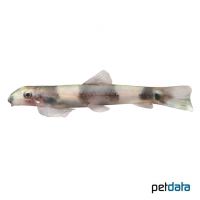Panda Loach (Yaoshania pachychilus)
| Panda Loach Yaoshania pachychilus | |
|---|---|
| Name | Panda Loach |
| Name Lat. | Yaoshania pachychilus |
| Synonym | Protomyzon pachychilus |
| Family | Hillstream Loaches |
| Family lat. | Gastromyzontidae |
| Order | Carps |
| Order lat. | Cypriniformes |
| Origin | South China |
| Habitat | Mountain streams |
| Diet | Omnivore |
| pH | 6.5-7.5 |
| Behavior | Peaceful |
| Keeping | Group |
| Care Level | Moderate |
| Reproduction | Egg scatterer |
| Breeding | Difficult |
| Life Span | 6-8 years |
| Protection | No |
| Metric Units | |
| Size | 5-6 cm |
| Temperature | 15-24 °C |
| Hardness | 2-15 °dH |
| Aquarium | ~ 100 l |
| US Units | |
| Size | 2"-2.4" |
| Temperature | 59-75 °F |
| Hardness | 36-267 ppm |
| Aquarium | ~ 25 gal |
Distribution and habitat
The range of the Panda Loach is in the Guangxi Zhuang region of southern China, where they are found in a few mid-mountain streams. They live in shallow and fast-flowing, oxygen-rich waters with sandy-gravelly bottoms and smooth stones.
Maintenance
The aquarium should have some robust plants, a substrate of sand and round-grained gravel, and large rounded stones and roots (hiding places). They need oxygen-rich water and a very strong current.
No ammonia, ammonium and nitrite should be detectable, the nitrate value should not exceed 100 mg/l. To ensure the water quality and oxygen content, a filter and heater adapted to the aquarium size is required, as well as lighting for the species-appropriate day-night rhythm of the animals.
Diet
They eat the plant cover (growth) of stones and wood and the microorganisms contained therein. For a balanced diet, feed them once a day with a high-quality sinking dry food (granules, tablets) as well as cyclops, daphnia or mosquito larvae (live or frozen). In addition, they need vegetable food, such as crushed peas, scalded spinach or algae leaves. It is recommended to coat stones or roots with a slurry of spirulina, chlorella and other algae powder and place them in the aquarium after they have dried
Only feed as much as will be eaten within a few minutes. A regular and varied diet promotes health and increases resistance.
Behaviour and compatibility
The lively, peaceful fish should be kept in a group of at least 5 animals. They can be well socialized with other, not too large and peaceful fish, such as danios, gobies, catfishes etc. but also shrimps (Caridina, Neocaridina)
Basically, only compatible fish species with similar demands on water conditions and water temperature should be socialized.
Sex dimorphism
The sexes are difficult to distinguish. The females are slightly larger and appear more rounded than the males. With some experience, the animals can be distinguished by their genital papilla.
Reproduction and breeding
A successful breeding in the aquarium has already succeeded several times. They are free spawners and spawn over coarse gravel. The approx. 1 mm large larvae hatch between the pebbles and feed there on microorganisms. After about a week, the approx. 1 cm large fry emerge from their gravel hiding place.
Fry must be fed several times a day with special rearing food (dust food, Artemia nauplii, microworms). In a community tank breeding is hardly possible, because the spawn is easy prey.
Important
The distinctive black and white, namesake markings occur only in juveniles.
Special attention should be paid to good water quality (high oxygen content) and a weekly partial water change is recommended. High temperatures are not tolerated.
They have large pectoral and pelvic fins, which are developed as adhesive organs and with which they can "hold on to stones" in the fast flowing waters. When changing location, they swim only short distances, fast and shallow over the bottom.
The well-being of the fish should be checked regularly. Temperature should be checked daily, pH, hardness and nitrate levels at least every 14 days. Regular partial water changes are recommended, even if the contaminant level has not yet reached the upper limit. Sudden changes in water quality should be avoided. Newly introduced fish must be accustomed slowly to the water in the aquarium
Further literature can be found in your pet store.
References
Text: Werner Winter; Image: petdata
Source: BMELV (1998): Tierschutzgutachten - Haltung von Zierfischen (Süßwasser); ENGELMANN (2005): Zootierhaltung - Tiere in menschlicher Obhut: Fische, Verlag Harri Deutsch
- Gemäß § 21 Abs. 5 Tierschutzgesetz idgF
